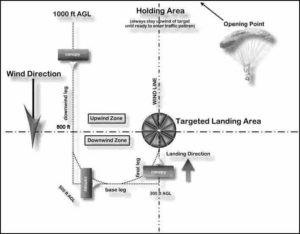How to Fly Your Parachute to Your Targeted Landing Area
Normally a skydiver should open their parachute in the Upwind Zone and on the Wind Line of the intended target.
The wind line is the direction the wind is blowing from. The opening distance upwind of the target is determined by the speed of the wind. The stronger the wind, the greater the distance upwind of the target that the parachute can be opened and still make it back to the target area.
After opening the parachute look for other parachutes while turning to face into the wind. Locate your target landing area.
Know the forecasted direction and velocity of the winds prior to your jump. Get familiar with prominent landmarks to help orient you with the wind after opening. If you have opened faced into the wind, look down at your feet, you should notice slow movement across the ground, sometimes you may be stationary or even backing up. We refer to this as HOLDING. If you look down at your feet and notice rapid movement across the ground, we refer to this as RUNNING. If while trying to fly straight towards a point you appear to be moving to the left or right, the wind is probably blowing from the side, this is referred to as CRABBING.
Descend under parachute while staying on the wind line in the upwind zone. Fly to the Target Area.
Plan to arrive alongside the target area at approximately 800 feet. At 800ft start your downwind leg.
Proceed Downwind for approximately 10 seconds, (5 seconds for stronger winds etc…) or approximately 500 feet before turning Base Leg. At approximately 300 feet turn back into the wind for your Final Approach to the target area. Once downwind of the target and below 800 feet avoid flying over obstacles (wooded areas, buildings, parking lots, etc…)
To avoid overshooting the target area on final approach, try 3/4 brakes to lose altitude. Avoid obstacles including other parachutist. Don’t fixate on the target area!

 Please Read Before You Book Your First Jump Course!
Please Read Before You Book Your First Jump Course!